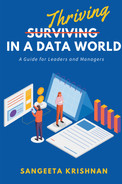Data analytics is a broad area that is constantly evolving. With the amount of information available about all things data, there is information overload. It’s tough to know where to start. This book’s aim was to outline all the vital data topics to benefit the nontechnical user.
Data is useful and valuable only when we know what to do with it. Otherwise, it is just a cost center being collected and stored. Undiscoverable data is useless, and if not properly governed, it can only bring security threats to the company. Remember to apply the principles of data analytics discussed in this book, such as calculating the ROI of your data projects. When it comes to data, many people seem to be kinesthetic learners who register a concept by doing. There is an influx of topics to learn about data and hence stay focused by picking an area, practice the tips in this book, and build on it.
Shape data functions in your organizations in order to create synergies. Eliminate and bridge the friction points in your organization by launching an effective data literacy program. Practice your data storytelling with simple examples, and experiment with the art of persuasion. Try out the visual language by creating something easy and relatable, like a visual résumé or your data journey map. Work toward clarity and simplicity in your data presentations, apply design thinking approaches, and fight the urge to show everything you analyzed with the data. Anticipate the needs of your organization and business stakeholders to propose the most impactful data solutions. And, to thrive in a data world, focus on learning the foundational elements of data analytics instead of simply learning the next fancy data tool.
